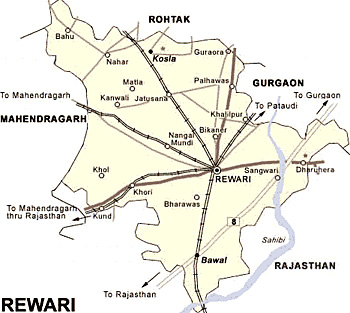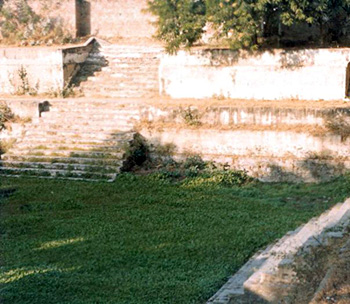 Rewari District is an administrative district of Haryana. It was accorded the status of a district by the state government of Haryana on 1st of November, 1989. Its geographical boundaries have district Jhajjar in its north, Mahendragarh district in its west and Gurgaon District in its east and north-east directions. Alwar District of Rajasthan touches Rewari in the south-east. Prior to it, Rewari was a sub-division and Tehsil headquarter of district Mahendragarh. This district is spread over 1559 sq km area. Rewari town, district headquarters, is situated at the height of 241.95 meters above sea level.
Rewari District is an administrative district of Haryana. It was accorded the status of a district by the state government of Haryana on 1st of November, 1989. Its geographical boundaries have district Jhajjar in its north, Mahendragarh district in its west and Gurgaon District in its east and north-east directions. Alwar District of Rajasthan touches Rewari in the south-east. Prior to it, Rewari was a sub-division and Tehsil headquarter of district Mahendragarh. This district is spread over 1559 sq km area. Rewari town, district headquarters, is situated at the height of 241.95 meters above sea level.
History of Rewari District
History of Rewari District is contemporary to the history of Delhi. During Mahabharata period there was a king named Rewat. The king founded and established a city named "Rewa wadi" after the name of his daughter. During the rule of Mughals, Rewari was a part of Delhi territory. In the freedom struggle of 1857 of the country against the British rule the district played a great role. Rewari District was mainly inhabited by the Gujjar community and Ahir community.
Geography of Rewari District
 In Rewari District temperature ranges from 2 degree Celsius to 47 degree Celsius, months of December and January are of severe cold and the months of May and June are extreme summer months. As this district shares its boundary with Rajasthan it experiences dusty storms in the summer season. Overall climate of this district remains dry. July, August and September are the months of rainy season. Light rains are experienced during December, January and February.
In Rewari District temperature ranges from 2 degree Celsius to 47 degree Celsius, months of December and January are of severe cold and the months of May and June are extreme summer months. As this district shares its boundary with Rajasthan it experiences dusty storms in the summer season. Overall climate of this district remains dry. July, August and September are the months of rainy season. Light rains are experienced during December, January and February.
Administration of Rewari District
Administration of Rewari District is divided into two sub-divisions, Rewari and Kosli. It is further divided into three revenue tehsils namely Rewari, Bawal and Kosli. Administrative set-up of Rewari District has five Community Development Blocks namely Rewari, Bawal, Khol, Jatusana and Nahar. This district consists of 412 villages and 348 Panchayats. Deputy Commissioner is the head of administration of this district.
Tourism in Rewari District
Rewari District offers various religious and historical places for exploring. The major tourist attractions of Rewari District are - the red mosque or Lal Masjid is among the famous historical places in the district. It was built during the regime of Akbar in the year 1570. Also there are two monuments near the mosque. Baag Wala Talab situated near Rewari is another popular attraction of Rewari District. It was built by Ram Ahir son of Rao Gujjarmal. Presently this pond is dry. Bada Talab is also a major attraction situated near old Town Hall of Rewari. It was built by Rao Tej Singh during 1810 - 1815. "Ghanteshwar Mandir" is among the famous religious places in the district. It is situated in the heart of city. A famous temple of Lord Hanuman is situated on the bank of Bada talab, this temple is visited by large number of devotees every Tuesday. There are two churches in the city. Apart from these sites are other several places in the rural areas namely the temple of "Baba Bhairon Nath" at Khol, temple of "Swamy Shrnanad" at Darauli, Ashram of "Baba Purshotam Das" at Balwari village, temple of "Baba Raghunath" at Sangwadi village and temple of "Baba Mohan Das" at the village Bharawas. Some of the above are monuments (Samadhi) and in the memory of these saints, the local people conduct village fairs every year. "Bhagwat Bhakti Ashram" of Rampura is also a famous historical place in Rewari District.
Rewari District has made unprecedented progress in the industrial front in the last few years. A number of policy initiatives announced by the Government of Haryana from time to time have provided impetus for a rapid growth of industries in this district.






